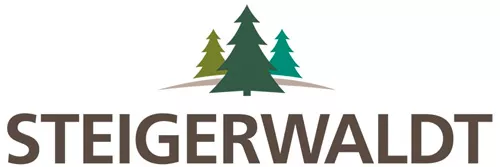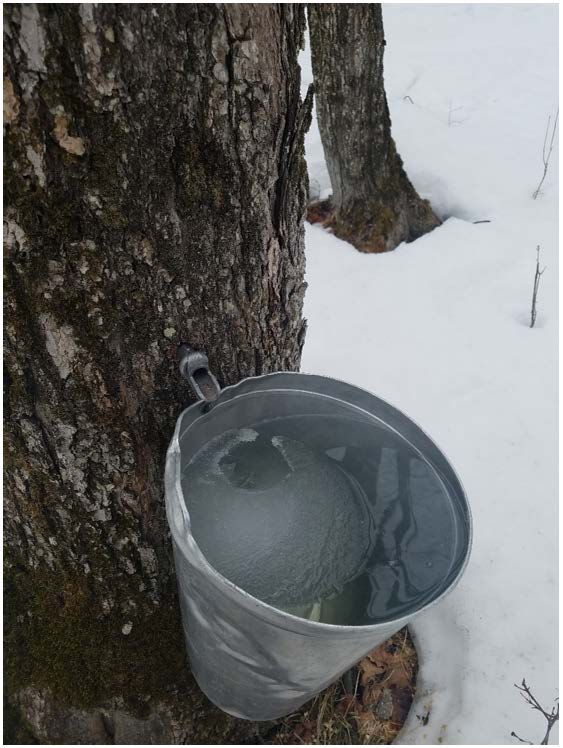Hello Everyone:
It’s hard to believe it’s spring already and maple syrup season is at hand. Every year we like to you know how the season begins and what we anticipate by the end of April.
As most of you already know we make maple syrup “the old-fashioned way” – hand tapping, collecting, and using wood-fired evaporation. I’ve attached a more in-depth process description to the end of the newsletter so as not to be repetitive with past writings.
This will be our 20th year making syrup and I can honestly say each has been fun, educational, and special to the whole family.
This season will be different than most because there is no frost in the ground. I cannot think of another year where this has happened, and I really don’t know how to predict the sap runs. My best guess is that it will be a short season with one, maybe two runs. We’ll have to wait and see; sap usually moves up the trees when temperatures get into the 40 to 45° range. The ground begins to thaw and the watery sap moves upward through the vascular parts of the trees.
Early winter was particularly warm and the snow that did drop ended up covering and insulating the ground. The snow then keeps the wet earth warm and prohibits freezing.
As the snow melts this spring, we will almost certainly get bare ground spots and some cold nights where the frost will penetrate somewhat around the roots. Hopefully that will start the freezing and thawing process that will give us the sap run.
We typically drill and tap approximately 180 trees each season and end up with 40 to 50 gallons of finished syrup. In anticipation of a short season we will probably tap more trees.
Tapping began on February 23, and we now have 200 trees with pails attached to the metal spiles.
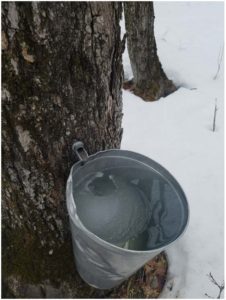
In this issue I wanted to provide more information about the syrup industry and the maple trees that make it all possible.
The North American syrup industry is surprisingly large and is dominated by Canada, which produces over 12 million gallons annually. Other large producers are Vermont with 2.7 million gallons, New Hampshire with 150,000 gallons, and Maine with 580,000 gallons. Wisconsin’s annual production has most recently been estimated at 270,000 gallons. It’s my opinion that most Wisconsin syrup is made by relatively small producers that enjoy the process more than the financial rewards. There are Wisconsin operations that tap 5,000 to 10,000 trees annually, but most tap 100 to 1,000 trees and produce 30 to 300 gallons of syrup.
I can’t figure out how anyone other than very large operators can be profitable at the syrup business. It is a labor of love with lots of time invested. This is especially true for those using more traditional techniques such as hand gathering sap from pails and using wood burning stoves for evaporation.
I once asked a producer who was selling syrup at the Dane County Farmers Market (the largest in Wisconsin) if he had a profitable season. His response was “I really don’t know, because I have always used the money to buy or fix up my equipment.” That is the way most small producers think and that is perfectly alright. There’s is just something special about taking gin-clean natural sap and turning it into a most wonderful finished tasting product from the woods.
Syrup can be made from various species in the maple family, including red maple, silver maple, box elder, and even black maple native to the Pacific Northwest. The sugar maple dominates the industry because it has the sap with the highest sugar content, which varies between about 1 and 5 percent and from my experience averages about 2 percent. This average sugar content equates to evaporating about 40 gallons of clean sap to yield 1 gallon of syrup. That is a lot of evaporation.
Most of the trees at Steigerwaldt taps are in the 12- to 24-inch diameter class, measured at 4 1/2 feet above ground. The most sap can be collected from larger diameter trees with broad spreading crowns.
Although each tree and each yield varies, I would say that on average our trees are responsible for making about 1 quart of finished syrup each.
Syrup producers must make a choice about future timber values if they contemplate tapping. Maple is a high-value timber species due to its strength and white wood. Think basketball courts, flooring, cabinets, and furniture. Once these trees are tapped the wood will begin to develop mineral streaking which imparts a dark stain on the interior white wood. Once trees are tapped, they usually drop in timber value.
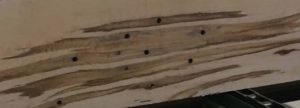
Mineral streaking on maple caused by tapping
I know I’ve had to stop and think twice about drilling an 18-inch diameter sugar maple with a clear trunk. This would be a high value veneer grade tree, but I reason I can still enjoy tasty Steigerwaldt syrup made from that tree long after it would have been harvested for lumber.
There is no shame in growing trees for quality lumber and veneer, but those close to the family log cabin and sap house have a special purpose and are worth keeping. Good forestry practices, including selective harvesting, can maintain a healthy forest for the future. Selective harvesting in maple stands creates openings where seedlings can get sufficient sunlight and grow into pole and sawtimber sizes. Maple forest tree values can vary wildly from under $1.00 to $2.00 up to $300.00 or more for 16- to 24-inch diameter and trees with few defects.
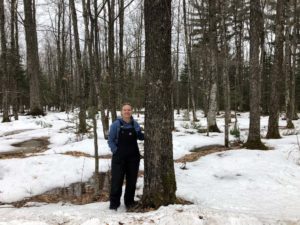
Lee with a veneer quality high-value maple
Here are some interesting maple-related facts:
- The sugar maple is Wisconsin’s state tree.
- Red maple (soft maple) has the same sugar content as sugar maple for about the first two weeks of the sap run. Then it drops to about half of the sugar maple’s content.
- Trees can be tapped annually if taps are rotated vertically or horizontally and about six inches apart.
- Early season syrup is often the lightest in color.
- son syrup is dark and has a somewhat stronger flavor due to minerals and nitrates showing up in the sap near the end of the season.
- $25.00 — Average value of a Steigerwaldt sugar maple used for maple syrup calculated by V =when value equals net income per tree divided by an income capitalization rate. Income is net income after all expenses including equipment depreciation, land rent, and taxes and labor. $2.00 ÷ 8 percent, $25.00 = $2.00 per tree net annual income might seem low but making syrup is labor intensive. There is little data on capitalization rates for small maple syrup operations. My best estimate is that a typical range would be 6 to 10 percent. I used 8 percent for example.
- $50.00 — Average value of a Steigerwaldt sugar maple if utilized for forest products.
- $1,200 to $1,800 per acre — Estimated cost to buy forest land suitable a maple syrup operation in northern Wisconsin.
- $2,000 to $5,000 — Equipment start-up cost for a basic maple syrup operation (evaporator, finishing unit, filters, and so on).
- Best Wisconsin hot dog — Natural cased, cooked in the sap evaporator at 3 o’clock (around this time the sap is almost syrup).
- Best cold beer — Any served with the above hot dog.
- Best simple dessert — Vanilla ice cream with Steigerwaldt maple syrup topped with salted pecans!
By now, you will have an idea of why we love the maple syrup process. It is very interesting, fun, and at the end of the day it is especially rewarding.
Currently we are about midway through the season and by March 29 we have evaporated approximately 800 gallons of sap and bottled about 22 gallons of syrup.
There have been two rather short runs and one large one that created overflowing 2- to 3-gallon pails for two to three days. I am hoping for at least one more big sap run. We will have to wait and see.
I hope everyone stays safe by maintaining distance when possible.
Please don’t hesitate to contact us if you have maple syrup questions. We normally invite everyone to stop by and visit, but under the circumstances we will be postponing the invite until 2021.
Maintain safe space and stay healthy.
Have a good, safe spring.
Ed and Mary Lee
